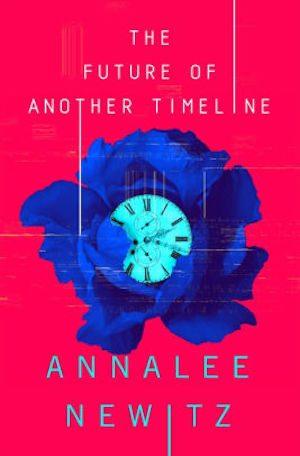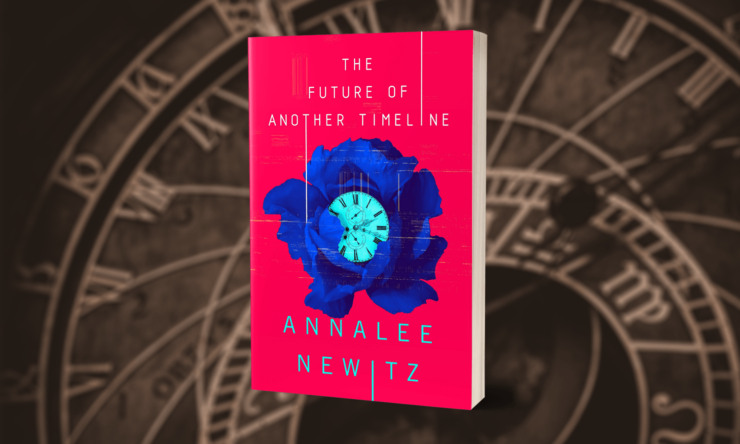Tess is a geologist who, under the cover of her historical research, seeks to edit the timeline to exert small positive influences against the efforts of “anti-travel activists.” Beth is a teenage punk on the cusp of adulthood in the early ‘90s who witnesses and helps cover up a killing, setting her own life veering onto a different course than she anticipated. Both women are activists at heart, surrounded by other women of all sorts invested in the struggle for justice, and both are inextricably linked to each other across time.
Because “Geologist” means something different in the world of The Future of Another Timeline: scientists and practitioners whose field of study surrounds the Machines, five constructs scattered across the globe that allow restricted travel through time using science so advanced as to seem like magic (depending on the time period). While the Machines are older than the human species itself, the group of men trying to destroy them—and in so doing, lock a terrible future into place—are making disturbing gains, unseen and unnoticed by anyone except Tess’s group of feminist geologists. As a final confrontation approaches, a collective of unlikely allies are all that stand against the creation of one terrible, final timeline.
The Future of Another Timeline is an absolute tour de force that wholeheartedly embraces the radical potential science fiction holds as a political genre. The novel plants its footing in the tradition of feminist sf that stretches from Joanna Russ backwards and forwards, exploring vital questions of power and resistance, what it means to be a woman, and what it means to fight. I savored it, I wept with it, I had to take rage-breaks with it. The book is a good book, in terms of craft and execution, but it’s also a fucking important book—an urgent book, a clear-seeing book, a book with ethics to argue as well as the passion to do so.
Spoilers follow.
Newitz’s comprehensively intersectional engagements with feminist activism are made real through Tess and Beth, as well as all the people who influence their lives and with whom they form coalitions, friendships, loves. Women academics of a whole variety participate in the Daughters of Harriet. One side-plot involves a moment when Tess realizes the Comstocker men are willing to kill because Beatrice, a trans woman member who is another member’s girlfriend, is murdered in the past—and Tess remembers her, but the girlfriend does not, so the girlfriend goes back with an insurance agent to rescue her. The rescue involves snuffing out the man who killed her.
There are also more, vastly more allies and friends outside of academic circles: labor unionists, spiritualists, punk girls, abolitionists, New Women, men who also believe in equity. Edits in the timeline might change relationships as the world changes, too, such as between Hamid and Beth. Rather than Beth losing touch with Hamid after an illegal abortion he did not understand, in the better timeline Hamid supports Beth in her trip to the clinic through a wall of protestors then the pair start their relationship over with kindness in college. Other, less pleasant relationships are important to acknowledge as well, like Beth’s to her mother, a woman who ignores the abuse of her own daughter, and Lizzy, who draws her friends into a set of revenge murders.
As that brief list of examples indicates, The Future of Another Timeline is multifaceted and unbelievably thorough in representing resistance. Gender, class, race, ethnicity, and ability are all influences on a given individual’s approach and understanding. The portions of the novel set at the Chicago Midway in 1893 are some of the most vibrant in their grappling with the problems of activism. For example, the defeat of Comstock’s agenda in the public imagination relied in part on the resistance of women… but in part also on getting the Gilded Age robber baron class to shift loyalties via a lavish, exploitative dancer’s competition-slash-revue. The compromise is not a comfortable or feel-good choice for Tess, but in the moment, it worked. The presence of allies like Sol, a Jewish man who’s pleased to work alongside a woman of color as his stage manager and to support her political aims, is also a vital signal to the ways in which coalitions exist across gender toward feminist praxis.
Newitz has brought to life the sensation of standing on the edge of the cliff of history, thinking: what can be done to change this? Futures are fragile, contested things reliant on an infinite amount of factors large and small. As one of the researchers in the book notes, regarding a timeline only she remembers where the Haitian revolution failed, “I don’t tell them everything about the timeline I remember. I don’t want them to know how close we are to that other version of history. I want them to have hope.”
With this same care toward sustaining hope, Newitz balances the terrors of living as a woman under patriarchy with the blistering, relentless, revolutionary possibilities of collective action. There were chapters I had to pause between in anxious, physical distress because the distance from here to there is so minimal. A United States where abortion was never legal, for example, is the one that most of the Daughters of Harriet remember and exist in during the novel. The male supremacist travelers who are attempting to lock the future into their hideous vision—a nightmare world of captive-breeder women spawned straight from the dregs of “men’s rights” forums—spew familiar internet lingo in their rhetoric of violence, domination, and destruction. It’s a future Morehshin has escaped from, but more importantly, it’s a future that has already happened unless the timelines are repaired.
Buy the Book


The Future of Another Timeline
There is hope, though, and a fight to be fought. The novel’s arguments come to rather glorious light through that process of struggle. One point articulated by Beth near the conclusion is that collective action and the theory of singular Great Men in history are best paired into a synthesis to understand how change happens. She says, “…now I could see that every great man was actually a tiny piece of something much larger: a movement, an institution, or possibly a set of loosely interconnected people.” Tess, however, has another path. She comes to accept that violence for its own sake is unethical—but resistant violence for defense, for safety, for setting things right is often necessary. Newitz offers humane, realistic, and intensely moving answers to the major questions of progressive activism through their novel, and none of those answers are simple or reducible. All require the participants to debate, understand, empathize, and make hard choices. But as Tess thinks earlier in the novel when considering the lineage of feminism,
“There were more of us beyond this room, all along the timeline. Some were organized subversives, and others were only half-aware that something was wrong in the world. We were fighting for liberation, or revenge, or maybe for a simple night of pleasure without shame. We were fighting to save each other, though we didn’t know each other. I thought about everyone else out there, walking this path with us, and wondered what they were doing right now.”
Across time, across space, across culture. There are so many people walking the path in so many ways, and all of those small things add up to something very, very big indeed. It’s a powerful message, tenderness and connection paired with an understanding of the importance of resistance and the occasional necessity of violence for the right ends.
On all possible levels, The Future of Another Timeline succeeds: as an illustrative argument about intersectional feminist alliances, as a treatise on activism and coalition-building across time and culture, and as a work of precise, finely constructed, beautiful science fiction. The prose is desperately anxious and handsome while the plot contains a vast sort of awe at time and space that strikes me silent when I consider it hard enough, yet tempers its grandeur with personal intimacy through characters and their relationships. But it’s the ethical questions at the heart of the novel, questions about resistance and revolution, that needed to be asked and answered—now as much as ever, because there are futures in the process of being made all the time—and Newitz has done so resoundingly, with grace.
The Future of Another Timeline is available from Tor Books.
Read an excerpt here.
Lee Mandelo is a writer, critic, and editor whose primary fields of interest are speculative fiction and queer literature, especially when the two coincide. They have two books out, Beyond Binary: Genderqueer and Sexually Fluid Speculative Fiction and We Wuz Pushed: On Joanna Russ and Radical Truth-telling, and in the past have edited for publications like Strange Horizons Magazine. Other work has been featured in magazines such as Stone Telling, Clarkesworld, Apex, and Ideomancer.










